New Drugs on the Horizon sessions feature first disclosures of 12 new anticancer therapies
//
Estimated Read Time:
This year’s three New Drugs on the Horizon sessions featured first disclosures on the structure, mechanism of action, and functional target modulation of 12 novel cancer agents. The sessions were part of the American Association for Cancer Research (AACR) Annual Meeting 2024, and they were sponsored by the AACR Chemistry in Cancer Research (CICR) working group.
The first two sessions took place Sunday, April 7, followed by a final session on Monday, April 8. All three are available on demand for registered Annual Meeting attendees through July 10, 2024, on the virtual meeting platform.
New Drugs on the Horizon: Part 1
Co-chairs Mary M. Mader, PhD, Indiana Biosciences Research Institute, and Benjamin L. Ebert, MD, PhD, FAACR, Dana-Farber Cancer Institute, led the session.
ABBV-303: A novel NK and CD8 T cell engager specific for c-MET-expressing tumors
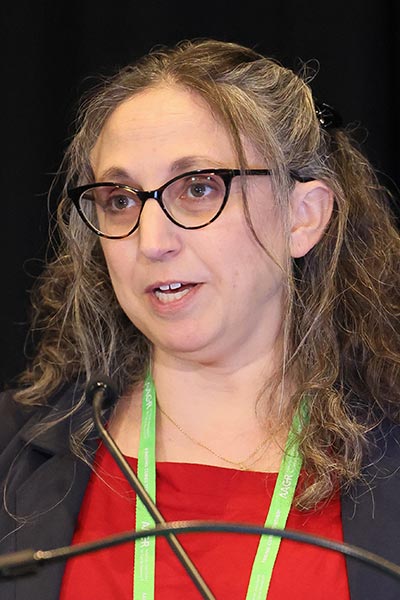
Jennifer Stone, PhD, principal research scientist at AbbVie Inc., presented findings on ABBV-303, a c-MET–targeted immune engager generated using the TriNKET® platform. ABBV-303 has three functional binding modules—a single-chain Fc high-affinity c-MET–binding module; an antibody fragment module that interacts with natural killer (NK) cells and activated CD8+ T cells; and a low-affinity binding module that engages a protein on NK cells and links the other two modules.
Stone reviewed functional data for ABBV-303 as well as safety data in a non-human primate multidose study.
Stone said, “We feel [that ABBV-303] complements current c-MET targeted therapeutics by bringing in a differentiated mechanism of action.”
ABBV-303 is currently being studied in a phase I clinical trial in patients with advanced solid tumors.
BMS-986365: a ligand-directed androgen receptor degrader (AR LDD) with a dual mechanism of action for the treatment of advanced prostate cancer
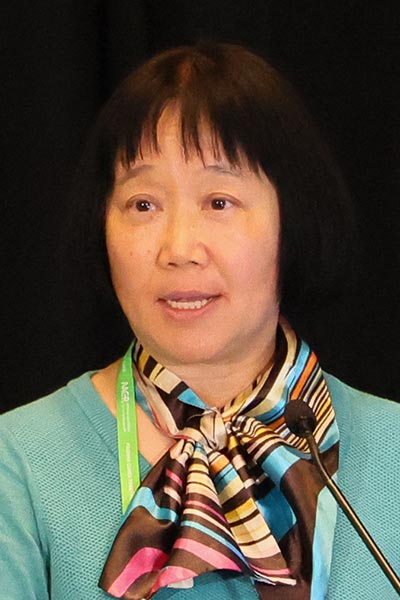
Shuichan Xu, PharmD, a scientific executive director at Bristol Myers Squibb, explained the rationale for developing BMS-986365, a first-in-class ligand-directed androgen receptor (AR) degrader and inhibitor, by reviewing the dependence of prostate cancers, both in castration-sensitive and -resistant settings, on the AR pathway for survival.
Amplification, overexpression, and mutation of AR in AR-dependent cancer contribute to resistance to AR pathway inhibitors. In this context, the dual mechanism of action of BMS-986365—an AR degrader and inhibitor—has the potential to overcome this resistance.
In first-in-human studies in post-AR pathway inhibitor metastatic castration-resistant prostate cancer, BMS-986365 exhibited clinical activity in the wild-type (WT) and WT-amplified AR settings.
Xu said, “We expect it to be clinically active in the earlier disease setting, such as first-line CRPC [castration-resistant prostate cancer] and CSPC [castration-sensitive prostate cancer] settings.”
RMC-9805: an oral, covalent, tri-complex KRASG12D(ON) inhibitor

John E. Knox, PhD, vice president of structural chemistry and discovery sciences at Revolution Medicines, highlighted the significant unmet need for therapies for RAS-mutant cancers, especially in the context of lack of response to KRASG12C-targeted therapies and with co-occurring mutations such as KRASG12D.
Knox said, “RASG12D has the largest unmet clinical need of any of the oncogenic mutations, with nearly 61,000 new patients [with tumors harboring this mutation] in the U.S. alone [annually].”
Knox reviewed the mechanism of action of RMC-9805, which binds to KRASG12D in its active “on” state and to its protein chaperone cyclophilin A, forming a tri-complex structure. This tri-complex precludes downstream effector binding with RASG12D. This agent is being evaluated in a first-in-human phase 1/1b study in patients with KRASG12D-mutant solid tumors.
ORIC-944: a novel inhibitor of PRC2 for the treatment of prostate cancer
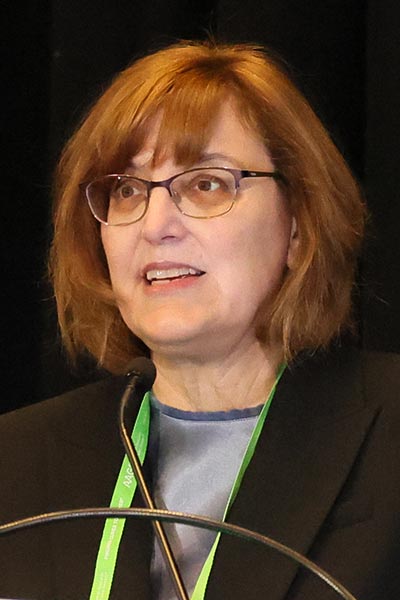
Lori S. Friedman, PhD, chief scientific officer of ORIC Pharmaceuticals, reviewed the approach to designing ORIC-944, a potential best-in-class inhibitor of the polycomb repressive complex 2 (PRC2)—which includes a histone H3 lysine 27 methylase, EZH2, and a histone-binding component, EED. While first-generation inhibitors of PRC2 targeted EZH2, ORIC-944 was designed to target the H3K27 trimethyl-binding pocket of EED.
ORIC-944 treatment suppressed prostate cancer cell growth, including in AR inhibitor-resistant cells. Prostate cancer xenograft model studies showed that treatment with ORIC-944, in combination with AR inhibitors, promoted tumor regression. An initial clinical dose-escalation trial showed that this agent was well tolerated by patients.
Friedman said that ORIC-944 demonstrated potential best-in-class drug properties with favorable safety and strong pharmacokinetic profiles. She added that clinical combination studies of ORIC-944 with AR inhibitors are slated to begin this year.
New Drugs on the Horizon: Part 2
Co-chairs Lori S. Friedman, PhD, ORIC Pharmaceuticals, and Hong Shen, PhD, Roche Research & Development Center, Shanghai, led the session.
ARV-393: a potent, orally bioavailable BCL6 targeting PROTAC® for the treatment of non-Hodgkin lymphoma

Dan Sherman, principal research investigator at Arvinas Inc., reviewed the role of dysregulation of B-cell lymphoma 6 (BCL6) in the initiation and progression of non-Hodgkin lymphoma (NHL). BCL6 is a zinc finger-containing homodimeric transcriptional repressor and a key modulator of B-cell responses.
Sherman said, “We were very interested in [developing] a BCL6 degrader as adding to the toolbox in the fight against [NHL].” Sherman and colleagues screened compounds to identify ARV-393, an orally bioavailable proteolysis-targeting chimera (PROTAC®) that degrades BCL6. AVR-393 drove tumor regression in patient-derived xenograft models of many NHL subtypes.
Sherman said that first-in-human clinical trials of ARV-393 are set to begin later in 2024.
AZD8421: a highly selective CDK2 inhibitor to address resistance to CDK4/6 inhibitors in breast and CCNE1-high cancers

Abnormal activation of cyclin-dependent kinases (CDKs) drives cancer-cell proliferation. CDK4/6 inhibitors, in combination with endocrine therapy, have become the standard of care for treatment of patients with hormone receptor-positive advanced breast cancer. However, primary and acquired resistance to CDK4/6 inhibitors remains a clinical challenge.
Christopher R. Denz, MS, director of Research & Development at AstraZeneca, reviewed CDK4/6 inhibitor resistance mechanisms, many of which converge on CDK2 dependency. He said, “This offers a therapeutic opportunity for CDK2 [inhibitors] to potentially address these [resistance] mechanisms.” He also noted that amplification of CCNE1, which encodes cyclin E1, is prevalent in many cancers, and CDK2 inhibition may have therapeutic effects in CCNE1-high cancers.
Denz and colleagues confirmed the potency and selectivity of AZD8421 for CDK2, including in CCNE1-high cells, and additive effects when combined with CDK4/6 inhibitors.
The CYCAD-1 phase I clinical trial of AZD8421 in patients with selected advanced/metastatic solid tumors has been initiated, Denz noted.
BBO-8520: a first-in-class, direct inhibitor of KRASG12C(ON)
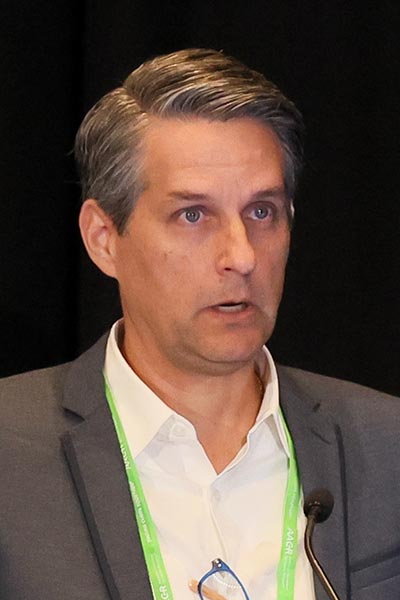
KRASG12C is one of the most common RAS mutations in non-small cell lung cancer (NSCLC).
Pedro J. Beltran, PhD, senior vice president at BridgeBio Pharma Inc., said, “The discovery of the switch II pocket [in KRAS] and the approval of sotorasib and adagrasib has resulted in clinical benefits for patients with KRASG12C mutations.” He noted that these approved KRASG12C inhibitors, as well as divarasib, are KRASG12C(OFF) inhibitors—they lock KRAS in its inactive, GDP-bound state. However, resistance commonly develops to these approved inhibitors.
To prevent resistance, Beltran suggested that the KRASG12C(ON) state—the GTP-bound form—needs to be captured to obtain a best-in-class KRASG12C inhibitor in NSCLC. He presented data on BBO-8520, a first-in-class inhibitor of both KRASG12C(ON) and KRASG12C (OFF). He said that BBO-8520 binds to the switch II pocket, locking GTP-bound KRASG12C in the state 1 conformation, which is unable to bind effectors.
Beltran said that the phase I ONKORAS-101 study of this agent in patients with advanced NSCLC is now open.
M3554: a novel anti-GD2 antibody drug conjugate

Christiane Amendt, PhD, principal scientist and project lead at Merck KGaA, presented data on a novel antibody-drug conjugate M3554, targeting GD2, a membrane-associated glycosphingolipid abundant in tumor cells with limited expression in normal adult tissues.
Amendt said that M3554 has modifications that mitigate antibody-dependent cell-mediated cytotoxicity and cell-dependent cytotoxicity, which are associated with unfavorable side effects of approved anti-GD2 antibodies. The cytotoxic payload of M3554 is a highly potent topoisomerase inhibitor, which is coupled to an anti-GD2 antibody via a hydrophilic linker.
Amendt reviewed M3554 design considerations, in vitro analyses, antitumor effects in patient-derived xenograft model studies, and tolerability evaluation in animal safety studies. She said, “Most importantly, [M3554] shows really strong and impressive [antitumor] activity in PDX [patient-derived xenograft] models of several indications—neuroblastoma, osteosarcoma, and glioma.”
New Drugs on the Horizon: Part 3
Co-chairs Michelle R. Arkin, PhD, University of California, San Francisco, and Ingo Hartung, PhD, Merck, led the session. The end of the session featured a slide with the structures of all 12 new drugs presented over the three sessions.
Actinium-225-PSMA-Trillium (BAY 3563254): a novel 225Ac-labeled PSMA-targeting small molecule triad for the treatment of mCRPC

Targeted radionuclide therapy (TRT)—in which cancer cell-homing molecules labeled with radionuclides, usually α or β emitters, deliver radiation directly to the tumor—is an emerging treatment modality in cancer.
Sabine Zitzmann-Kolbe, PhD, researcher at Bayer AG, presented data on a novel α-emitting agent, Actinium-225-PSMA-Trillium (BAY 3563254), that targets prostate-specific membrane antigen (PSMA).
Zitzmann-Kolbe and team fine-tuned the design of BAY 3563254 to address some of the limitations with current PSMA-targeted TRTs. A phase 0 imaging and dosimetry study of this agent has been completed.
Zitzmann-Kolbe said that a first-in-human phase I study evaluating this TRT in patients with advanced castration-resistant prostate cancer is currently open.
NST-628: a novel, potent, and fully brain-penetrant MAPK pathway molecular glue that inhibits RAS- and RAF-driven cancers
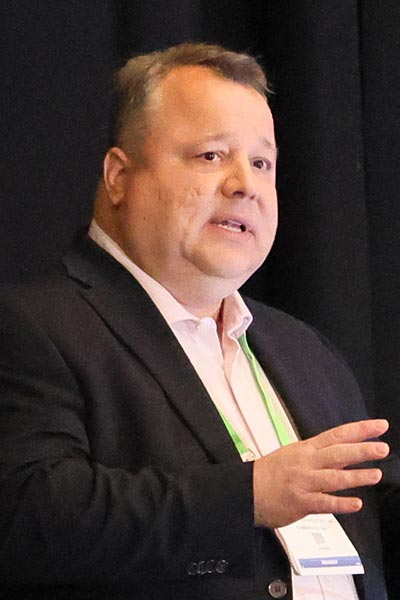
Klaus P. Hoeflich, PhD, chief scientific officer at Nested Therapeutics, presented data on the development of NST-628, a fully brain-penetrant molecular glue acting on key nodes of the RAS/MAPK pathway.
He said, “The RAS/MAPK pathway has been the heartland of cancer research for many years. But, as we know, significant unmet need remains.” Hoeflich said that most RAS/MAPK pathway proteins that are altered in cancer currently do not have any corresponding targeted therapies; moreover, current therapies targeting this pathway are vulnerable to reactivation, contributing to therapeutic resistance.
Hoeflich and colleagues sought to develop a molecular glue targeting RAF heterodimers, which are found downstream of reactivation mechanisms, and developed NST-628. Hoeflich said that NST-628 prevents activation of MEK by RAF and prevents the formation of RAF heterodimers.
NST-628 was shown to be fully brain penetrant and suppressed tumor growth in orthotropic intracranial tumor models. Hoeflich said that a phase I study of this agent is currently enrolling patients.
VVD-214: a synthetic lethal allosteric inhibitor of WRN helicase
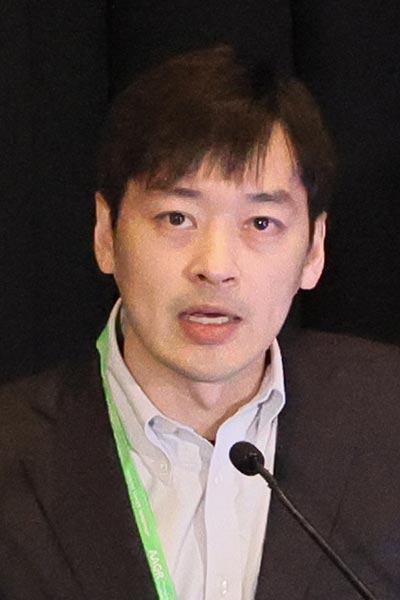
Shota Kikuchi, PhD, director of medicinal chemistry at Vividion Therapeutics, and Piergiorgio Pettazzoni, PhD, senior principal scientist at Hoffmann-La Roche, focused on VVD-214, a synthetic lethal ATP-cooperative inhibitor of WRN helicase.
High microsatellite instability (MSI-H) occurs in endometrial, colon, and stomach cancers, among others. Kikuchi reviewed the discovery of WRN, a RecQ family DNA helicase, as a synthetic lethal target of therapeutic interest in MSI-H cancers. He said, “This strong dependency of MSI-H cancers on WRN is akin to other high-value oncology targets.”
Using a chemical proteomics approach, the researchers identified highly selective WRN inhibitors, including VVD-214. In MSI-H cell and mouse tumor model studies, VVD-214 demonstrated anticancer activity. Pettazzoni and collaborators also confirmed the antitumor activity of VVD-214 in immune checkpoint-resistant MSI-H patient-derived xenograft models.
VVD-214 is currently being evaluated in a phase I dose-escalation study.
PF-07220060: a potent and selective CDK4 inhibitor
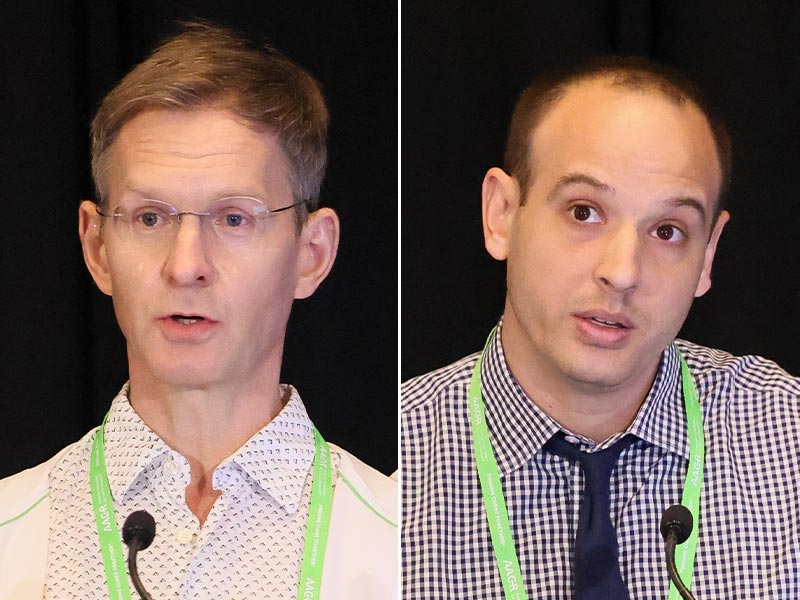
Lars Anders, PhD, associate research fellow at Pfizer, and Gary Gallego, PhD, senior principal scientist at Pfizer, focused on the first-in-class CDK4 inhibitor, PF-07220060.
Anders asked whether the dual CDK4/6 inhibitors, the current standard-of-care therapy for treating hormone receptor-positive, human epidermal growth factor 2-negative breast cancer, are indeed the best options, as CDK4 is the primary oncogenic driver in this context. He also highlighted some of the challenges and limitations of currently available CDK4/6 inhibitors.
Anders said that their approach to CDK4 inhibitor development focused on reducing toxicity by sparing CDK6, maximizing CDK4 coverage, and abrogating aberrant cell cycle transition and tumor growth.
Gallego reviewed the design, medicinal chemistry aspects, and preclinical characterization of PF-07220060. Anders presented data demonstrating the selectivity of PF-07220060 for CDK4 over CDK6 and its antitumor activity in animal models.
Anders reviewed data from a first-in-human phase 1/2 study of PF-07220060 in patients with advanced solid tumors. He said that the data showed reduced rates of neutropenia and gastrointestinal toxicity with this compound compared to those reported for dual CDK4/6 inhibitors. He also noted the encouraging clinical efficacy profile of this agent in the study.




